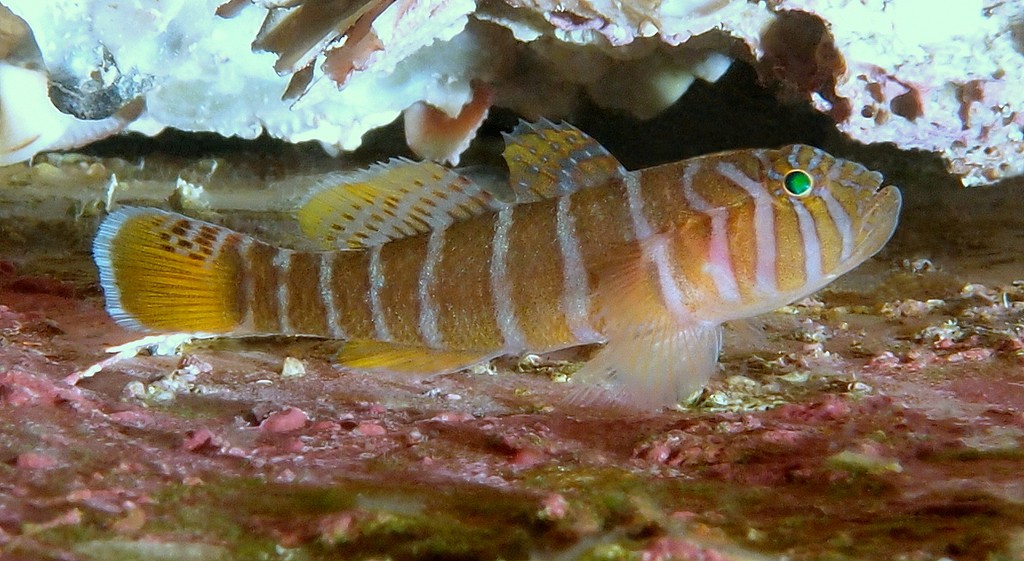PRIOLEPIS AKIHITOI - (HOESE & LARSON, 2010)
Actinopterygii (Gigaclass) > Actinopteri (Class) > Teleostei (Subclass) > Gobiiformes (Order) > Gobioidei (Suborder) > Gobiidae (Family) > Gobiinae (Subfamily) > Priolepis (Genus)
Emperor reefgoby, Kokuten-benkeihaze, コクテンベンケイハゼ,
Description
Dorsal spines (total): 7; Dorsal soft rays (total): 9-10; Anal spines: 1; Anal soft rays: 8; Pectoral fin rays: 20. Eyes slightly elevated resulting in a shallow pit in interorbital area and a shallow groove along dorsoposterior margin of eye; Ctenoid scales completely covering predorsal, reaching to above mideye, anteriormost scales sometimes cycloid, no naked patch immediately before the first dorsal spine; Small cycloid scales cover pectoral base; 11-13 rows of small cycloid scales cover prepelvic area; Cheek usually no scales, rarely with 1 or 2 scales near dorsoposterior margin of preoperculum; Operculum with a patch of small ctenoid scales dorsally; Sensory papilla rows on cheek with transverse pattern; Pelvic fins connected to form a plate, no interspinal membrane mouth oblique, forming an angle of about 40°-45° with body axis. Max. length: 5.3 cm SL. Depth range: 3 - 25 m.
Color
Head and body with narrow light bands, and with dark edges; A large elongate black spot anteriorly on first dorsal fin; 3-4 short vertical dark brown bars on dorsal part of caudal fin.
Etymology
Priolepis: from Greek, prion, -onos = saw + from Greek, lepis = a scale of a fish. Referring to ctenoid scales on body.
akihitoi: named for the Emperor of Japan, Akihito, for his significant and innovative contributions to the systematics of gobioid fishes.
Original description: Priolepis akihitoi Hoese & Larson, 2010 - Type locality: Futo, Ito City, Shizuoka Prefecture, Japan, depth 25 meters.
Distribution
Western Pacific: Japan, New Caledonia and Australia.
Emperor reefgoby, Kokuten-benkeihaze, コクテンベンケイハゼ,
Description
Dorsal spines (total): 7; Dorsal soft rays (total): 9-10; Anal spines: 1; Anal soft rays: 8; Pectoral fin rays: 20. Eyes slightly elevated resulting in a shallow pit in interorbital area and a shallow groove along dorsoposterior margin of eye; Ctenoid scales completely covering predorsal, reaching to above mideye, anteriormost scales sometimes cycloid, no naked patch immediately before the first dorsal spine; Small cycloid scales cover pectoral base; 11-13 rows of small cycloid scales cover prepelvic area; Cheek usually no scales, rarely with 1 or 2 scales near dorsoposterior margin of preoperculum; Operculum with a patch of small ctenoid scales dorsally; Sensory papilla rows on cheek with transverse pattern; Pelvic fins connected to form a plate, no interspinal membrane mouth oblique, forming an angle of about 40°-45° with body axis. Max. length: 5.3 cm SL. Depth range: 3 - 25 m.
Color
Head and body with narrow light bands, and with dark edges; A large elongate black spot anteriorly on first dorsal fin; 3-4 short vertical dark brown bars on dorsal part of caudal fin.
Etymology
Priolepis: from Greek, prion, -onos = saw + from Greek, lepis = a scale of a fish. Referring to ctenoid scales on body.
akihitoi: named for the Emperor of Japan, Akihito, for his significant and innovative contributions to the systematics of gobioid fishes.
Original description: Priolepis akihitoi Hoese & Larson, 2010 - Type locality: Futo, Ito City, Shizuoka Prefecture, Japan, depth 25 meters.
Distribution
Western Pacific: Japan, New Caledonia and Australia.
Biology
Hides in caves and crevices, also among corals or rock. Feeds on small invertebrates and zooplankton.
Hides in caves and crevices, also among corals or rock. Feeds on small invertebrates and zooplankton.
Similar species
- Priolepis cincta (Regan, 1908) - Reported from New Caledonia - Link to the species (here). Alternating dark-edged brown and narrower white bars on head and body; Dorsal and caudal fins with brown spotting; Basal part of dorsal fins with dark spots/bands.
- Priolepis pallidicincta (Winterbottom & Burridge, 1993) - Reported from Western Pacific: Brunei to Indonesia and Fiji, north to Philippines, south to Queensland (Australia). Alternating yellowish-brown and pale grey to whitish bars on head and body; Six broad yellow-brown bars on body.
- Priolepis profunda (Weber, 1909) - Reported from Indo-West Pacific: Kochi (southwestern India), Myanmar and Andaman Islands (India) east to Papua New Guinea, south to western Australia. Head and body brown with a distinct large black blotch at anterior base of first dorsal fin, and in life, head and body with very thin blue bands.
- Priolepis squamogena (Winterbottom & Burridge, 1989) - Reported from New Caledonia (Loyalty Islands). The color is very similar to that of Priolepis akihitoi, but is more yellow.
Last update: 5, May 2024
